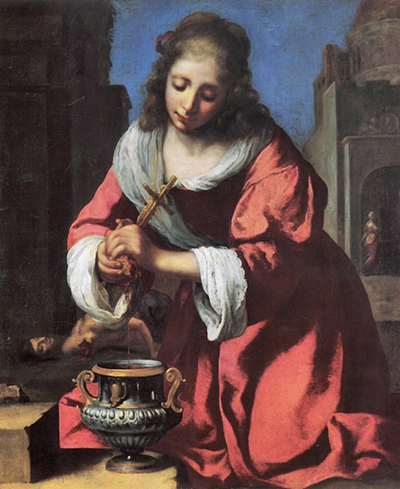The painting Saint Praxedis manifests the magnificent artistry of Johannes Vermeer towards the end of his career.
The illusive captivation of Vermeer's work grants the 17th century artist the power to receive recognition centuries after his time.
The painting manifests the Roman martyr of Saint Praxedis as the focal essence of the oil on canvas painting. The woman within the painting is hunched on her knees as she squeezes a martyr's blood into a oriental vessel.
Vermeer is known to have highly studied the work of artist Leonardo Di Vinci, as characteristic evident through the technique used to paint the portrait.
The setting of the artwork is based outside, holding a significant resemblance to the colossal architecture of Italy at the time. The renaissance look showcased throughout the artwork is a classic style Vermeer enjoyed displaying throughout his work. The artist had used an array of captivating shades in teal blue, ash grey, and dark brown to display the background of the artwork.
The woman is kneeling on her knees in a bright red dress. The red dress covers her full silhouette in a lush flow that hugs her body down her arms and to her feet.
The dress is accentuated through white ruffles at the sleeve of the woman and neckline. Vermeer always showcased this white accessory throughout his work in order to depict the classic style during the 1650's. A grey shawl is hung around the womanÕs neck lightly covering her chest as it disappears into the background of her body.
The woman holds a Christian crucifix within her hands alongside a cloth as she gently squeezes blood from a drenched cloth. The blood drips in a sharp stream down into a metal vase covered in an array of colours and forms. The base of the vase is covered in a deep blue colour, alongside 4 equal gold handles that accentuate the art piece.
The vase is lined with a few other strips of gold that add to the luxury of the item. The interesting element to note within the scene of the woman squeezing the blood into the vase is the crucifix that she holds within her hands as she proceeds with the action. These movements of the woman seem to resemble a religious ritual that covets the blood of the dead into a holy entity.
The captivating element to target within the artwork is the calm facial expression the woman holds as she proceeds with squeezing the blood out of the cloth.
Vermeer had depicted a light smile across the woman's face that brings up the question of whether the maiden is enjoying the act of squeezing out blood from a cloth. Upon first glance at he artwork, the viewer is unaware of the interesting approach the woman holds towards the act, unaware as to what she is squeezing.
Behind the woman the viewer is able to witness a male body on the floor with his head chopped of laying besides him. The blood seems to be coming from his open flesh as he lays lifeless on the cold tile. The woman seems unparsed through the brutal act occurring behind her and instead attempts to covet the blood from the cloth.
The captivating scenery within the artwork is an altered approach for the artist as his usual artworks showcase the normal everyday life of the Dutch people. This reviving painting was conceived near the end of the artist life, manifesting a different direction the artist was heading in his work.




